Reviews on SCI Journals of Traditional Medicine from 2013-2017
Zhou Ajin (周阿劍), Liu Zining (劉子寧), Meng Fnhong (孟凡紅), Zou Jinhu (鄒建華)
a: Center for Translation, World Federation of Chinese Medicine Societies, Beijing 100010, China
b: Institute of Information on Traditional Chinese Medicine, China Academy of Chinese Medical Sciences, Beijing 100700, China
ABSTRACT OBJECTIVE: To give a general introduction of journals on traditional medicine, which have been collected by the Science Citation Index (SCI). METHODS: A keyword search was conducted on the SCIE journals on the Thomson Reuters website (http://www.thomsonscientific.com.cn) with the search formula "Alternative OR Complementary OR Integrative OR Chinese Medicine OR Medicinal OR Ethnopharmacology OR Manipulative OR Natural Medicine OR Natural Product OR Phytotherapy OR Phytomedicine OR Homeopathy OR Acupuncture OR Planta OR Traditional OR Ayurvedic OR Herb OR Herbal". RESULTS: A total of 32 kinds of traditional medicine journals were collected by SCI,of which 30 are in English and the rest are in German.The subject of traditional medical journals covered by SCI covers traditional medicine, supplementary and alternative therapies, botanicals, and natural medicines. Chinese medicine professionals in China can take these factors into consideration when using literature or choosing the direction of paper submission. CONCLUSION: The IF of traditional medicine related journals are relative low, while those of biology and natural drugs are relative high. IF should not be considered as the only factor to evaluate the impact and academic level of journals.
KEY WORDS: Science citation index; Traditional medicine; Reviews
INTRODUCTION OF S CI
The Science Citation Index (SCI) is a citation index originally produced by the Institute for Scientific Information (ISI) and created by Eugene Garfield. It was officially launched in 1964. It isnow owned by Clarivate Analytics (previously the Intellectual Property and Science business of Thomson Reuters)[1-4]. The larger version(Science Citation Index Expanded) covers more than 8,500 notable and significant journals, across 150 disciplines,from 1900 to the present. These are alternatively described as the world's leading journals of science and technology,because of a rigorous selection process[5-7].
The subject content of the SCI collected literature is relatively extensive, but mainly focuses on basic sciences,such as physics, chemistry, biology, environment, medicine,agronomy and life sciences, etc., and rarely collects literature on engineering technology. SCI's collection of documents are from more than 150 disciplines, in over 40 countries (mainly the United States, UK, France, the Netherlands, Germany, Russia, Japan, Canada and China,etc.), with more than 3500 core journals[8].
The selection requirements for the documents included in the SCI are quite strict. In the selection process, the publication time, editorial specifications,thesis requirements, review standards, content setting,citation analysis, and internationalization level are all clearly defined. More importantly, to ensure the selection of high-quality literature, it uses a combination of citation data analysis and peer review to put the academic value of literature first.
The SCI's multidisciplinary database has two purposes: first, to identify what each scientist has published, and second, where and how often the papers by that scientist are cited[2].
OVERVIEW OF TRADITIONAL MEDICINE SCI JOURNALS
Data collection
A keyword search was conducted on the SCIE journals on the Thomson Reuters website (http://www.thomsonscientific.com.cn)[9]with the search formula"Alternative OR Complementary OR Integrative OR Chinese Medicine OR Medicinal OR Ethnopharmacology OR Manipulative OR Natural Medicine OR Natural Product OR Phytotherapy OR Phytomedicine OR Homeopathy OR Acupuncture OR Planta OR Traditional OR Ayurvedic OR Herb OR Herbal".After the search results are obtained, duplicates and non-traditional medical journals are removed to obtain the list of traditional medical journals included in the SCI. Further,in the 2013-2017 JCR[10], the relevant citation data of the traditional medical journals retrieved were searched.
General conditions of SCI traditional medicine journals
At present, a total of 32 kinds of traditional medicine journals were collected by SCI, of which 30 are in English and the rest are in German. The earliest journal was published in 1911, but most of them started after the 1980s. 9 of the journals were founded after 2000 and the latest was in 2009. See Table 1.
Region distribution of SCI journals
These journals are mainly published by European and American countries, of which 10 are in the United States(31.25%), 10 in UK (31.25%), 6 in other European countries and Australia (18.75%), 4 in Asian countries (including 2 in mainland, China), and 2 in African countries (Figure 1).
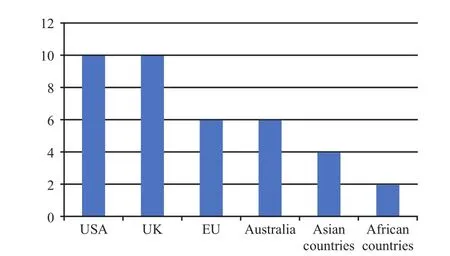
Figure 1. Region distribution of SCI journals
Topics of SCI journals
Of the 32 periodicals, 14 (46.67%) were special issues for natural products, 10 (36.67%) were general journals for complementary alternative medicine, 3 were integrated medicine journals, and 3 acupuncture journals.And chiropractic therapy journals and homeopathic remedy journal are 1 for each (Figure 2).
IF distribution
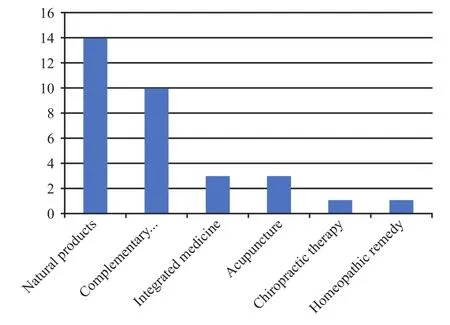
Figure 2. Topics of SCI journals
From the impact factors (IF) of the 32 SCI journals,it can be found that all together the impact factor of 11(34.38%) journals are over 2, and 14 (43.75%) between 1 to 1.99, and 7 (21.87%) below 1. The journal with the highest IF is Natural Product Reports, which mainly publishes original research articles in the field of natural products and organic chemistry (Figure 3).

Figure 3. IF distribution
Year of establishment
For the year of establishment, from 1911-1952,there were only 2 journals, 6 journals from 1953 to 1979,15 journals were established between 1980 and 1999, and 9 journals were established after 2000. We could see that the top of establishing traditional medicine journals is from 1980-1999 (Figure 4).
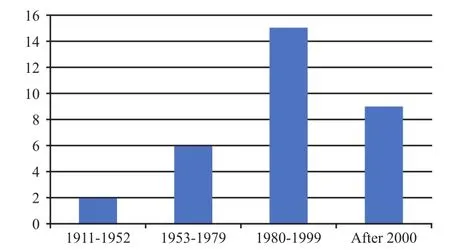
Figure 4. Year of establishment
Frequency of publication
For the frequency of publication, there is no too much difference among these 32 journals. All together 7 journals were publishing monthly, 7 bimonthly, 11 quarterly, and the rest 7 were non-scheduled. We could see that the most SCI journals on TM are published quarterly (Figure 5).
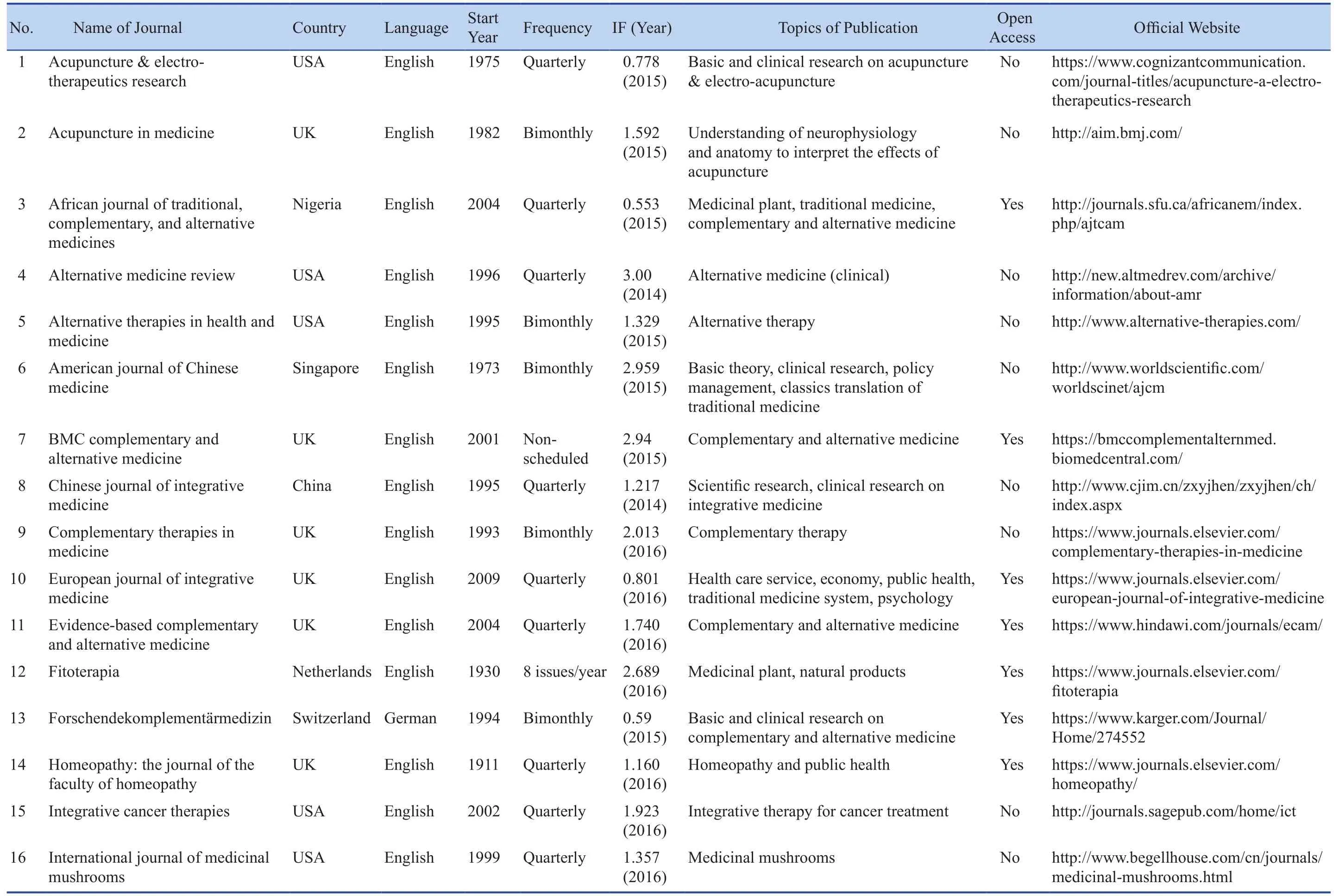
Table 1. General information of SCI included traditional medicine journals
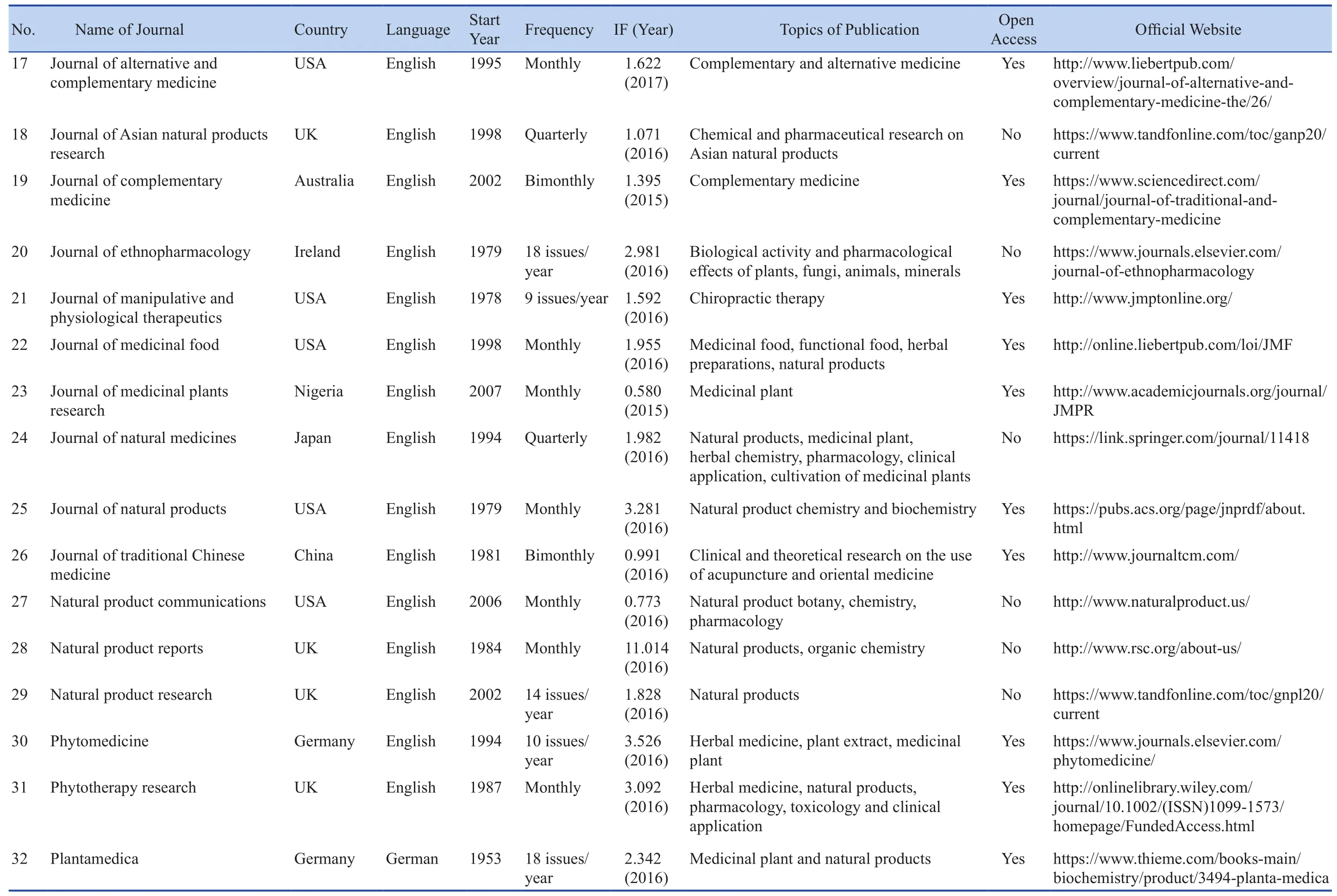
(Continued)
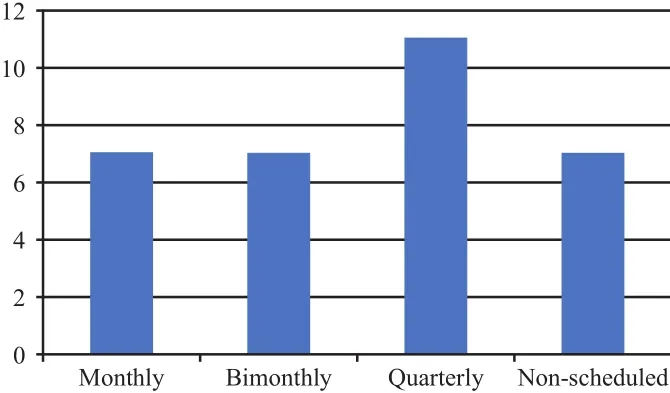
Figure 5. Frequency of publication
INTRODUCTION OF SEVERAL SCI JOURNALS
The following are several SCI journals with high possibilities which Chinese scholars submit their research papers to.
Phytomedicine
Phytomedicine is a peer-reviewed scientific journal in the fields of plant pharmacology, plant therapy and plant toxicology, which was firstly published in 1994 and edited by Hildebea Wagner. Phytomedicine published clinical trials, as well as research results in plant pharmacology, pharmacology, standardization and plant toxicology, including plant extracts and compounds isolated from these extracts. Phytomedicine published articles mainly include case reports, pharmacology and molecular biology studies, screening studies (only those with special activity in plant extracts and isolated compounds), chemical structure activity studies, chemical analyses and standardization studies of botanicals, and special reviews. The impact factor is 3.526 in 2016.(http://www.phytomedicinejourna1.com/)
Alternative Medicine Review
Alternative Medicine Review is a peer-reviewed complementary and alternative medicine journal published by Thorne Research in the United States in 1996. It is publishing 4 times a year, and it is specifically designed to share information related to complementary and alternative therapies. It aims to provide preventive health practitioners with accurate, timely and clinical relevant original articles, abstracts, and literature reviews. The journal is now indexed by Medline, EMBASE, CINAHL, Current Contents/Clinical Medicine,and United States Science Citation Index. "Science Citation Index Expanded (SCI-E)" and other databases are included. The journal mainly publishes literature reviews, original research, editorial notes, feature articles,and book reviews that have clinical value for health care practitioners. The impact factor in 2014 was 3.0. (http://altmedrev.com/)
Journal of Ethnopharmacology
Journal of Ethnopharmacology mainly publishes original articles focusing on observations and experimental studies of the biological activities of plants and animals used in past and present traditional medicine.The journal particularly welcomes interdisciplinary papers and applications ofethnic pharmacology,ethnobotany, and ethnic chemistry research.Studies in the fields of anthropology and ethnobotany have also belonged to the scope of the publication of the journal,and studies involving pharmacological and toxicological mechanisms have been particularly welcomed. Clinical efficacy studies may also be accepted for publication if they are considered to promote understanding of specific ethnic pharmacology issues.The journal welcomes review articles in these areas, especially those that emphasize the multidisciplinary nature of ethnic pharmacology. Only special guest comments are accepted.The impact factor is 2.981 in 2016. (http://www.ethnopharmacology.org/ISE_journa1.htm)
Complementary Therapies in Medicine
Complementary Therapies in Medicine was founded in 1993 and is an international peer-reviewed journal published in the UK. It is bimonthly published and its main audience is family doctors, nurses, and physiotherapists and health practitioners, such as doctors of complementary therapies.Every issue publishes some of the original, high-quality clinical research in the field of complementary medicine, as well as experience and relevant information that integrated complementary medicine with mainstream health care methods. Strictly related research papers and serious discussion papers are designed to promote the promotion of health care.Because some forms of complementary and alternative medicine research has novel and complex intervention methods.The journal encourages in-depth exploration of research methods. Personnel should always adopt high standards in the methodology and ethical aspects of the study, although small-scale or exploratory studies in this field are also welcomed. Well-designed studies with negative results in health care will also be considered.The journal welcomes contend for different opinions, and other types of articles may also be accepted. The impact factor is 2.013 in 2016. (https://www.journals.elsevier.com/complementary-therapies-in-medicine)
Evidence-Based Complementary and Alternative Medicine
Evidence-Based Complementary and Alternative Medicine (eCAM) is a publicly-accessed, international peer-reviewed journal founded by Professor Edwin L.Cooper of the University of California in 2004. Edwin L.Professor Cooper was editor-in-chief of the journal from 2004 to 2010. eCAM seeks to trace the roots of ancient and modern complementary and alternative medicine and encourages the application of rigorous scientific research methods in studies that complementary andalternative medicine, particularly in Asia. In the traditional medical treatment system, the journal pays attention to curative effect and tries to explore the mechanism of action of various therapies, and advances the research progress of basic research, clinical research, methodology, and scientific theory in various fields of biomedicine. The journal uses modern scientific methods to evaluate the unconventional alternative medicine system outside modern western medicine so that it can establish relevant standards for this emerging, more disorderly domain.eCAM receives articles of higher scientific quality.Clinical research, methodology and medical history or medical philosophy related to complementary and alternative medicine articles can be submitted to the journal.The articles published by the journal include basic research and clinical research, covering the following areas: botanical pharmacotherapy (herbal medicine),ayurveda medicine, traditional Chinese medicine, Chinese medicine, homeopathy, acupuncture and acupressure therapy, hydrotherapy (bath therapy), related animal molecular science, neuroimmunology etc. The journal will also consider natural animal and plant molecular research articles from other sources.The impact factor is 1.740 in 2016. (http://www.hindawi.corrdjour-nals/ecam/)
Journal of Alternative and Complementary Medicine
Journal of Alternative and Complementary Medicine is a bimonthly journal published by the New York Company, a well-known publisher in the field of biomedicine. It is an official journal of the International Society of Complementary Medical Research and the Acupuncture Research Association. It is also aninternational peer-review journal containing information on the observation and analysis of various therapies outside the western medicine field, reports,opinions, and comments.These therapies are receiving more and more attention, and are worth studying, and can be evaluated the value of clinical treatment.The journal also publishes new therapies in current clinical treatments,including related case reports, which are of special value for clinicians and other healthcare professionals in evaluating and combining these therapies in patient treatment programs. Its main purpose is to establish a rigorous and reasonable research method, improve the standards for the publication of the paper to ensure the validity and reliability of the evaluation methods and data collection, analysis and processing.The impact factor is 1.622 in 2017. (http://www.1i.ebertpub.com/acm)
Chinese Journal of Integrative Medicine
Chinese Journal of Integrative Medicine was founded in 1995 as a quarterly journal, formerly known as Chinese Journal of Integrated Traditional and Western Medicine and in 2003 it was renamed Chinese Journal of Integrative Medicine. It was selected as SCI-E in 2007,bimonthly as 2009, and monthly as 2011. The journal has been successively included by SCIE, MEDLINE,Chemical Abstract (CA), EMBASE, Abstract Journal(VINITI), and Ullrich's International Journal Guide(Ulrich's International Periodicals Directory), Poland's Index of Copurnicus (IC), British Center for Agriculture and Bioscience International (CABI) and other international search institutions scientific and technical journal database, Chinese core journal database (10,000 database), Chinese academic journal comprehensive evaluation database (Tsinghua database). The journal is governed by the State Administration of Traditional Chinese Medicine, hosted by the China Society of Integ ratedTraditionalChineseandWesternMedicine and China Academy of Chinese Medical Sciences. It is also the first peer-reviewed journal in the field of integrated medicine that is included in the SCI. The journal aims to promote international exchanges in combination with medicine and alternative medicine, and timely publication of scientific papers reflecting the latest developments in the fields of medicine or alternative medicine, trends, and clinical practice, scientific research, education, and health care.The journal's column settings include editors, hotspots,reviews, topical talk, works, clinical experience, case reports, evidence-based combination medicine, traditional medicine, interactions between Chinese and Western medicine, literature research, academic discussion,ideas and methods, and regulatory guidelines,summary,interdisciplinary knowledge, continuing education,meeting minutes, letters from readers, celebrity introductions, book reviews, advertisements, exquisite presentations, conference previews, etc. The impact factor in 2014 was 1.217. (http://www.cjim.cn/zxyjhen/zxyjhen/ch/index.aspx.)
Journal of Traditional Chinese Medicine
Journal of Traditional Chinese Medicine is a national academic journal of Chinese medicine cosponsored by the China Association of Chinese Medicine and Chinese Academy of Chinese Medical Sciences.Founded in 1955, monthly, published at home and abroad. The English version of Journal of Traditional Chinese Medicine was first published in 1981 and is now published in more than 90 countries and regions.It is the most important window for the exchange of traditional Chinese medicine. The English version of Journal of Traditional Chinese Medicine has been included in MEDLINE since 1982 and is the first Chinese medicine journal published by MEDLINE. Since 2010,it has been listed as a SCI-E source journal. It is the only comprehensive academic journal of Chinese medicine among the more than 30 general medicine and alternative medicine journals collected by SCI. Columns include evidence-based research, theoretical research, basic research, clinical observation, Chinese medicine research,literature research, ideas and methods, and reviews.The content is based on the report of the foundation of Chinese medicine, clinical research results and advances in scientific research, covering all areas of Chinese medicine disciplines. The impact factor is 0.991 in 2016.(http://www.journaltcm.com/)
European Journal of Integrative Medicine
European Journal of Integrative Medicine receives submissions from various fields in the field of complementary and alternative medicine, with special focus on the entire health care system, public health, selfmanagement and traditional medical systems. The journal is committed to mainstream medicine and evidencebased. The combination of complementary medicines encourages research on combining clinical practice and cross-professional education.Targeted readers of European Journal of Integrative Medicineinclude mainstream medicine and integrated medicine,including medical practitioners, researchers, health care organization personnel, and medical educators and those seeking to integrate objective and critical information in medicine. European Journal of Integrative Medicine provides researchers and clinicians with an international, interdisciplinary platform that connects the two. The journal focuses primarily on original research articles, including systematic reviews, randomized controlled trials, other clinical studies, qualitative studies,observational studies, and epidemiological studies.In addition, the journal also welcomes brief evaluation articles, review articles, and health services and policies,and health economics. The impact factor is 0.559 in 2016.(https://www.journals.elsevier.com/european-journal-ofintegrative-medicine/)
ANALYSIS
Market awareness and publishing mode of English periodicals in China
Elsevier in the Netherlands, Springer in Germany(in cooperation with Nature in 2017), NPG in the UK(now Springer-Nature), OUP, CUP, SAGE, T&F, etc., the United States has professional societies such as ASCO,ASC, and headquarters in the United States, but already developed into a global organization IEEE, they all have their own academic publishing organizations. However,it is regrettable that as of today, there has not been an English journal, academic publishing group or platform,or a single product in China that can independently go to the global market for profits from academic publishing.
Even though CNKI has recently worked hard to achieve this goal, it is forgiven that only from the perspective of resources, it is impossible to gather China's high-quality resources, because 310 domestic(72%) English journals choose to cooperate with foreign publishers. Everyone understands that the foreign content of the copyrighted content of the cooperative periodicals is attributable to foreign companies and has no right to transfer to CNKI. Therefore, it is possible to foresee the market efficiency in the later period unless there is a new idea to focus on what the market needs.
As we know that a standard international journal must abide by and conform to international publishing standards, such as COPE's publication ethical code,ORCID Open Researcher logo, and a series of digital logos promoted by CrossRef, etc.; And it must have good international integration, such as the author, readers,citations, including open academic markets, degree of display in international databases, etc.; and it also actively become a member of international associations (eg STM,SSP, ALPSP, etc.), openlyand collaboratively participate in the exchange of this industry, and jointlydiscuss and respond to changes and innovations in this industry.
For the assessment of high-impact journals, people think that it should be defined in terms of both quantitative and qualitative aspects. Quantitative factors, such as IF, Cite Metric, etc., can indeed reflect the substantive impact indicators of the output produced within a certain discipline; Qualitative factors, like some disciplines, may not be based on quantitative indicators, but their products can generate influence on policy orientations, technical reports, etc. of government and enterprises, or awards,praises, or presentations in international assessments.They are also indicators of in fluence.
DISCUSSION
In fluence of SCI journals of traditional medicine
In order to ensure the most important and in fluential scientific research in the world, ISI adopted strict review procedures and selection criteria when selecting SCI journals. Therefore, it can be said that the journals covered by SCI basically have an important in fluence in science and technology academic circles. In recent years,the number of traditional medical journals collected by SCI has been increased, which shows that traditional medical science has received increasing attention in the academic community, and the level of traditional medical academic publishing has also been continuously improved.
However, it should be noted that the overall in fluence of traditional medical journals is still relatively low compared with other disciplines. Such as the oncology professional journal CA:a cancer journal forclinicians had an in fluence factor of 74.575 in 2008 and the impact factor of the New England Journal of Medicine reached 50.017. The impact factor of Natural Product Reports ranked first in impact factors in traditional medical journals was only 11.04, and the average impact factor of the 32 traditional medical journals was only 1.684.Since the 2007 edition, two new indicators, the Eigenfactor?Score and the Article In fluence? Score, have been added to the JCR. Compared with the impact factor, the score of the Eigen factor is calculated based on the quotation of the published papers in the past 5 years, and the selfquotation of the journal is deducted. The statistics on the journal citation include the natural sciences and the social sciences, which is more comprehensive and complete.The paper's impact scores are designed to measure the relative importance of a journal based on each paper,calculated by dividing the score of the feature factor by the normalized ratio of the paper published by the journal(the total number of papers in all journals is 1). The average value of the paper's impact score is 1.00, which is greater than 1.00, which indicates that the in fluence of each paper in the journal is higher than the average level,and less than 1.00 indicates that the impact of each paper in the journal is lower than the average. The 2008 Journal of Natural Products had the highest characteristic score of 0.028 14. It had a 47-fold difference from the Journal of Biological Chemistry (1.329 99), which ranked first in the feature factor. The impact scores of traditional medical journal articles were mostly less than 1.00, indicating that the influence of the papers in most traditional medical journals was lower than the average. These data show that the academic in fluence of traditional medical journals is still at a low level.
Topics of SCI journals of traditional medicine
Among the traditional medical journals collected by SCI, professional journals such as natural products,medicinal plants, and plant medicines account for the majority, and most journals with high impact factors and characteristic factors are also such journals. This may be related to the research ideas and research methods of botanicals and natural products that are more closely related to mainstream natural science research methods. The Natural Product Reports ranking first among the impact factors in traditional medical journals is a publication that focuses on research articles on natural products and organic chemistry. The systems and thinking methods of traditional medicine and complementary therapy are different from the generally accepted scientific methods, and therefore relatively difficult to be understood and accepted by the mainstream community,which shows that there is a lot of work to do to reveal the clinical experience of TCM. We need to create the evaluation method and evidence based clinical research on TCM.
Area distribution of SCI journals of traditional medicine
Although traditional medicine has become more influential in developing countries, more practices and researches have been carried out, and academic publications have become more abundant. However,most of the traditional medical journals that SCI collects are published by European and American countries. The reason may be unfamiliar with the citation rules. Besides that, the evaluation on the quality of research is limited.An objective evaluation system should be set up and more evidence based research should be increased. As the birthplace of traditional Chinese medicine, China's traditional medical academic exchanges and publications are highly developed. However, due to various reasons,our country's traditional medical journals have not been able to enter the SCI for a long time, and they have not been able to fully play their role in international academic exchanges. Fortunately, the "Chinese journal of integrative medicine" and the Journal of traditional Chinese medicinehavenow been included in SCIE. This is more important to introduce TCM into the western countries and improve in China's traditional academic publishing field.
CONCLUSION
By analyzing the profile of the traditional medical journals covered by the SCI and its cited statistical data,we could see that the influence of journals on TCM is gradually increasing although there is still some space for the ideal international academic influence of traditional medical journals. The subject of traditional medical journals covered by SCI covers traditional medicine,complementaryandalternative therapies, botanicals, and natural medicines, among which professional journals related to natural medicines have more advantages in terms of quantity and in fluence. Chinese medicine professionals in China can take these factors into consideration when using literature or choosing the direction of paper submission. The IF of traditionalmedicine related journals are relative low, while those of biology and natural drugs are relative high. So we could not consider IF the only factor to evaluate the impact and academic level of journals.As the origin of Chinese medicine, great attentions should be paid to the construction of English journals in Chinese medicine, to make the Chinese medicine journals in fluential around the world.
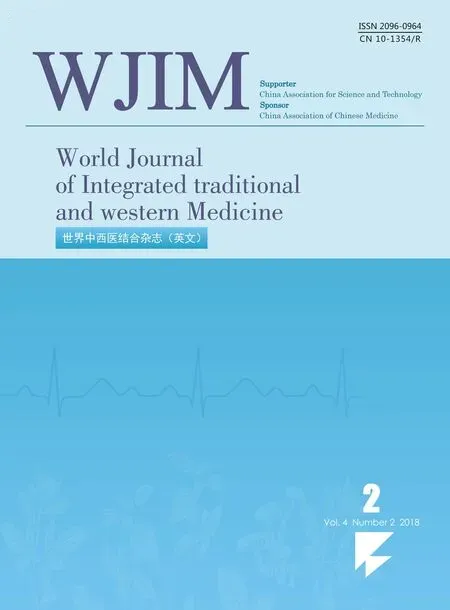 World Journal of Integrated Traditional and Western Medicine2018年2期
World Journal of Integrated Traditional and Western Medicine2018年2期
- World Journal of Integrated Traditional and Western Medicine的其它文章
- New Year's Message
- Clinical Research on the Treatment of Simple Obesity by Oral Chinese Medicine Combined with Health Education to Improve Phlegm Dampness Constitution
- Clinical Research on Alleviating Pain for Patients with Ankylosing Spondylitis and Their Active Function by Acupuncture with Chinese Medicine Fuming and Steaming
- Therapeutic Advantages of Traditional Chinese Medicine in Non-erosive Reflux Disease
- World Integrated Medicine Master Chen Keji
